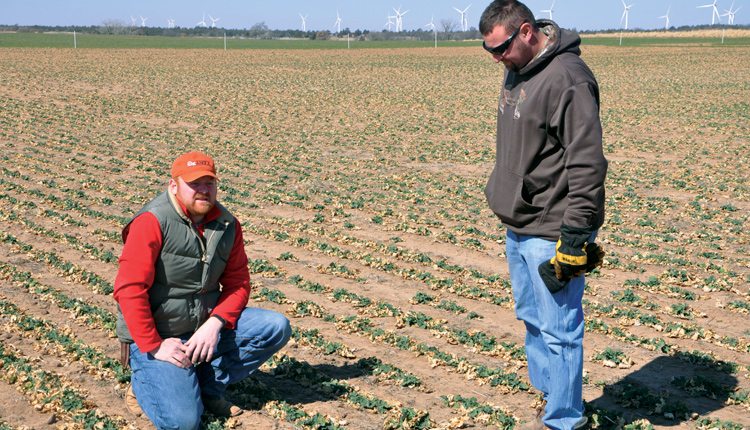Great Plains farmers seeking to increase wheat yields turn to canola with the help of experts.
Seed Companies are helping farmers increase wheat yields in the Great Plains by encouraging them to incorporate canola as part of their rotation.
Unlike spring canola production, which has been used in northern states such as North Dakota and Montana, winter canola serves as a rotational crop for winter wheat in areas of Texas, Oklahoma, Kansas and beyond.
However, climate restrictions in states with severe summers have led some farmers to plant wheat on the same land for 50, or even 100 years in a row.
“If that’s all they’re growing, they aren’t getting the yields they need to be sustainable,” says Heath Sanders, a canola field specialist for the Great Plains Canola Association.
Research from Oklahoma State University shows that canola can increase wheat yields 10 percent to 15 percent. However, Sanders has seen on-farm data show up to a 30 percent increase.
“It’s a significant bump,” he says. “If you get a 30 percent increase each year, after three years, you’re gaining almost an entire year’s worth of profit.
Yield increases have also been noted when canola is planted in rotation with soybeans and grain sorghum.
Cody Daft, a DuPont Pioneer field agronomist for the Western Business Unit, agrees the benefits are substantial. “We plant close to 6 million acres of wheat, a lot of which is continuous,” Daft says. “In addition to cleaning up those fields, canola is also a broadleaf crop with a taproot so we see an increase in soil tilth.”
Steve Marten of Marten Farms in Holliday, Texas, has been farming canola for about five years, despite the drought. “It’s so beneficial to get away from monoculture,” Marten says. “Any other rotational crop we’ve had in the past has been another grass crop like oats, so it’s good to have a broadleaf option.”
Profit Potential
The yield benefits for wheat are a great bonus, but the canola is also quite valuable, even though it was originally considered just a natural herbicide, according to Josh Lofton, an Oklahoma State University cropping systems specialist.
“Twelve years ago, we were just using it to clean up wheat fields, but it has turned into a potentially very profitable crop,” Lofton says, noting that canola also provides a great flowering crop for honeybee forage.
Mark Torno, diverse field crops marketing manager for Winfield Solutions, LLC, a Land O’Lakes company, has been working with canola in North Dakota for 20 years.
“There are two main reasons for farmers to bring in a crop like canola,” Torno says. “Usually, they are considering it as a rotation crop for wheat, but it’s also about making money.”
Canola oil is the third largest source of vegetable oil in the world, following soybean oil and palm oil. Use continues to grow and the market has typically been strong for this healthy option.
Plus, there are few additional input investments. For seed costs, he explains farmers are looking at $28 to $30 an acre for canola and around $28 for dual purpose wheat.
“It’s very comparable,” says Eric Devuyst, an Oklahoma State University professor and Extension economist.
However, canola prices have dropped in recent years, in some cases as much as 25 percent. Still, Devuyst expects to see the commodity continue to increase in popularity.
“Just because there isn’t a huge economic advantage like we had doesn’t mean farmers won’t be using it,” he says.
Jeff Scott of Scott Farms in Pond Creek, Okla., plans to stick with canola through the decline.
“Using canola allows us to get a premium for our wheat,” he says. “I have the elevators and processors calling me to buy. It works to our advantage to keep canola in the rotation.”
Acreage Increases
In 2015, there were nearly 1.8 million acres of canola planted in the United States, according to data from the U.S. Department of Agriculture’s National Agricultural Statistics Service. A majority of those acres are spring-planted in northern states such as North Dakota. However, southern states such as Oklahoma and Texas are seeing a growing number of winter canola acreage as the niche crop moves slightly more into the mainstream.
Oklahoma is now the second-biggest canola producing state. The 2015 harvest provided a major rebound for canola production in the state, after the drought devastated harvest in 2014.
“In 2015, Oklahoma harvested around 125,000 acres of canola,” Devuyst says. “In 2014, those numbers were even higher before the drought caused some guys to back off.”
Compared to 2009 — the first year Devuyst has records for the state — the increase is significant. In those six years, canola production in Oklahoma increased from 31,000 acres harvested for a value of $7.4 million to more than $14.4 million in 2014.
Other states are also working to integrate canola into their rotations. Total canola acreage for the Great Plains area in 2014 was around 200,000, including farms in Oklahoma, Texas, Kansas and nearby states, Sanders says.
Know the Challenges
Canola is a smaller seed and can be challenging to work with, but investment costs are low because the crop uses small grain equipment, limiting the need for new machinery investments.
Scott shares that the majority of the equipment he uses is all the same.
“One thing we’re doing differently is swathing,” he says.
Scott has noticed farmers are hiring custom swathers to harvest canola, much the same as farmers who have wheat custom cut.
The timeline is similar to wheat but Daft says it needs to go in a little earlier. “It’s important to get canola in the ground by the latter half of September,” he shares. “With wheat, you have until the end of October.”
Additionally, canola is very sensitive to crop residue, which can be a challenge for farmers who operate a no-till system.
One of the main challenges is simply finding the right nutrient balance.
“Sulphur is a unique requirement for canola, and it’s a challenging nutrient to deal with,” Torno says, noting that it’s difficult to get accurate field tests because sulphur levels vary drastically. “I usually tell new guys to go with their usual wheat nutrients, but be sure to add sulphur because adding nitrogen without adding sulphur could be worse for yields than no added nutrients.”
Moving Forward
Scott was one of the earliest canola growers in Oklahoma, and when he began, there were not many resources available for farmers to reference.
“We messed up every way we could,” he shares. “We fought through it and have been successful,”
Now, Scott serves as president of the Great Plains Canola Association as well as the U.S. Canola Association, both of which are good resources for anyone wanting to learn more about canola.
Additionally, seed company representatives who sell canola seed are available and have resources to help farmers through the learning curve.
“If we sell a product, we have a staff member like myself, as well as other local experts, who are very willing to help teach those management techniques,” Daft says of Pioneer.
Torno agrees that the seed companies are a good place to start.
“We’re very committed to canola, sunflowers, and wheat,” Torno says of Winfield, adding that many other companies tend to focus primarily on corn and soybeans. “It’s a smaller industry, and the people involved care about it.”
Lofton is optimistic about the future of canola. “We’re not trying to move away from wheat totally, of course, but this is really breathing new life into a lot of farms,” he shares.
For many, the goal is for canola to become more of a primary crop, although Sanders would be pleased if more farmers rotated one-third of their wheat acreage with canola each year. He thinks the benefits would be significant.
“Canola acres won’t ever rival total wheat acres, but there are a lot of possibilities if we can get the weather to cooperate,” Sanders says.












